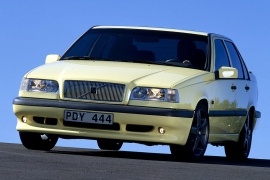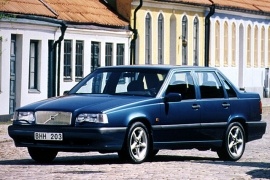VOLVO 850 Models/Series Timeline, Specifications & Photos
First production year: 1992
Engines: Gasoline, Diesel
Volvo tried to be more appealing to the younger generation, and, for that, it introduced the 850 lineup in 1992, followed by the sporty 850 R in 1994.
The Swedish carmaker was confident that its safe cars were good enough to handle a more powerful version. So it pushed the boundaries to its engineering department and introduced a turbocharged version for the 850, and offered it in both shapes: sedan and station wagon. Moreover, in 1994, the carmaker entered the BTCC (British Touring Car Championship) with the wagon-shaped version. In the 1995 season, it entered with the more common sedan sibling, the 850 R.
The revolutionary design of the 850 was seen as a massive leap for the Swedish carmaker. Still, dropping the wedged shapes was not easy, but it was a promising start. The car featured a sloped hood with rounded edges and corners, a curved windshield, and, exclusively for the R-version, a lower front apron that sports the fog lights and three air-intakes. At the back, the car received a small wing on the trunk.
The interior was roomier since the car was no longer a front-wheel drive vehicle. There was enough legroom for both the front and the rear seat passengers. Still, the carmaker's design team didn't completely drop the squared design and apply it to the dashboard, which featured a tall center stack penned with straight lines.
Under the hood, Volvo installed a turbocharged five-cylinder engine that provided 240 PS (237 hp). The standard transmission was a five-speed manual, and power was sent to the front wheel. The 850 R featured stiffer suspension and wider light-alloy wheels, unlike its less-powered siblings.
The 850 was a big leap forward for the Swedish car-maker. It didn't look like a brick on wheels anymore in terms of styling and, moreover, it was a front-wheel-drive vehicle. Later on, it was fitted with an all-wheel-drive system. The Swedish winters were long and snowy. The 850 was the first car in the world fitted with side-airbags.
The new design language took everybody by surprise. The sloped hood, rounded edges, and curved windshield were just a few elements that made the 850 so special in Volvo's history. It was inspired by the bigger 960 model, but it wasn't just a scaled-down vehicle. It retained the small, triangular, window behind the rear doors. The flat and straight trunk was still a part of the old school, but it looked better on the new 850.
Inside, due to the front-wheel-drive system, it wasn't that cramped anymore in the front. The wide seats with bolstered sides offered a comfortable ride. The transverse engine canceled most of the vibrations. The dashboard was still in cubic style design, with a big center stack. In the back, there was room for two adults and, as an option, an integrated child seat in the middle.
The 850 was offered with a choice of engine diesel and gasoline. Some engines were carried-over from other car-makers, and some were developed by Volvo engineers. The standard transmission was a 5-speed manual for the entire range, but selected versions were offered with an option for a 4-speed automatic.

